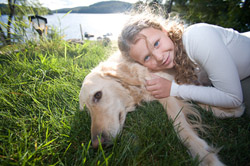Pesticides Can Linger in Your Kitchen for Decades! What This Means for Your Health, Your Kids and Your Pets
by www.SixWise.com
Two study findings on pesticide use in the home give more reason to avoid these dangerous chemicals. Children and pets were cited as the most susceptible to exposure to the toxins released from pesticides.

Pesticides frequently linger on floors for decades after they’re used! |
Some of these commonly used pesticides include insect killer sprays for roaches, ants, wasps, fleas and ticks and other pests that cause nuisance in the home, lawn and garden. The first study conducted by the Environmental Protection Agency (EPA) showed that these types of frequently used household pesticides lingered in the home for decades after being used.
The EPA estimated that approximately 165 pesticide compounds were also possible carcinogens. Another study linked pesticides to the following health complications:
- Adverse effects on childhood development and reproduction
- Parkinson’s disease
- Obesity
- Leukemia from exposure to pesticides during pregnancy
One of the most startling results of the study revealed that most U.S. kitchen floors are infested with toxic pesticides. Despite the study findings, these potentially harmful pesticides continue to stay on store shelves.
Eight of the Most Common Pesticides/Contaminants Found in U.S. Homes
- Permethrin—Detected in 89 percent of the homes--an insecticide found in some head lice treatments and pet products such as flea and tick killers and insect repellants
- Chlorpyrifos—Detected in 78 percent of the homes—a toxic crystalline used for pest control and used with the trade name of Dursban until 2001
- Chlordane—Detected in 74 percent of the homes—an insecticide that was used on home lawns and gardens until it was banned in 1984
- Piperonyl butoxide—Detected in 52 percent of the homes—a chemical mixed with pyrethrin and similar pesticides used to kill wasps, ants, fleas, ticks and lice
- Cypermethrin—Detected in 46 percent of the homes—an insecticide found in ant and roach killers and in popular brands such as Raid
- DDT—Detected in 33 percent of the homes—an insecticide widely used for many years to kill mosquitoes and other pesty insects until it was banned in 1972
- Fipronil—Detected in 40 percent of homes—an insecticide found in the following brand name pest control products: Frontline, TopChoice, Over’n Out! and Maxforce
- Diazinon—Detected in 35 percent of homes—an insecticide that was commonly used to kill ants and roaches before it was banned in 2004
What Kinds of Pesticides are in Your Home and Who’s Most at Risk?
You may not realize it, but pesticides may be infiltrating more of the inside of your home than the chemicals used on your lawn.
According to a study conducted by the EPA, 75 percent of U.S. households use at least one pesticide product in their home and another study revealed that 80 percent of people exposed to pesticides are exposed inside of the home, measuring up to nearly a dozen pesticides in the air. Some of the most commonly found pesticides in the home include rodent sprays, kitchen and bathroom disinfectants and flea and tick shampoos and powders for pets.
Those most susceptible to the harmful vapors of these pesticides are children. Studies have shown that there are three reasons why children are more at risk than adults:
Flea 'n Tick B Gone: The Natural and Safe Way to Beat Fleas, Ticks and Other Pests

If you put typical flea and tick treatments on your dog, the toxic pesticides not only reside on your dog … they get transferred into your home and could potentially contaminate everything you and your family touches.
Flea 'n Tick B Gone is a safe and incredibly effective alternative. It’s an enzyme-based formula made naturally from plant resources, so it's entirely free of the neurotoxic pesticides that make up conventional flea and tick treatments. Flea 'n Tick B Gone is:
- 100% Pesticide Free
- Non-toxic
- Clinically proven to be highly effective
- A Great Value! Eliminates the need for collars, bombs, foggers, powders, etc., and is economically priced
- Can also be used on bedding and pet areas of the home--Simply lightly spray in these areas
- Reduces vet and medicinal costs
- Can safely be used as a preventive against fleas and ticks: Regular use can naturally break life cycle of fleas
- Controls other in-home pests
- Reduces risk of infections, dermatitis and itching
- Safely removes fleas, ticks, lice and other pests
- Makes an entirely non-toxic, insect repellant for your backyard. Just mist the area and you'll be tick- and bug-free for at least three hours!
|
- First, these chemicals are more likely to disrupt the normal growth process of their brains and other organs, along with upsetting their hormone levels at critical developmental stages due to the rapid development of their body.
- Secondly, because they are so much smaller in size and breathe at a rapid rate, any dose becomes greatly magnified.
- A third reason revolves around their everyday habits such as crawling on the floor and picking up everything and putting in their mouth opening themselves up to a myriad of dangerous chemicals on the ground.
A new study revealed that children up to the age of 7 are a greater risk of pesticide exposure due to their biological makeup. The study found that their bodies are unable to produce enough of a detoxifying enzyme that allows adults to get rid of organophosphate chemicals, a pesticide used that attacks the nervous systems of bugs.
Health effects of pesticides can range from the mild such as irritation to your eyes, nose and throat to the serious such as damage to your central nervous system and kidneys and an increased risk of cancer.
How to Keep Pesticides From Infiltrating Your Home
You may not be able to completely remove all pesticides from your home, but you can dramatically reduce exposure to them. Here are some practical and natural ways to protect your house and family from the dangerous chemicals and toxins:
- Do some research on the least toxic method of conquering common household pests such as trying natural insect repellants that don’t contain harsh chemicals and natural flea and tick sprays such as pesticide-free Flea and Tick B Gone.
All-Natural Flea 'n Tick B Gone is an ideal alternative because it's an enzyme-based formula made naturally from plant resources that you can use as an entirely non-toxic, insect repellant for your backyard. Just mist the area and you'll be tick- and bug-free for at least three hours!
- Prevent pest control problems before they even enter the home by:
- Getting rid of standing water in plant trays
- Fix leaky pipes or faucets
- Remove or be sure to dry out water-damaged and wet materials
- Do a thorough once-over for hidden pests on any boxes or packages before bringing them into the house
- Avoid storing newspapers, bags or boxes
- Avoid using flea collars and tags, which are literally soaked in chemical pesticides, emitting a continuous toxic cloud into the air, not only for your pet, but for you and your family -- Choose Flea 'n Tick B Gone instead.
- Avoid the use of toxic pesticides in your home and yard.
- If you are pregnant, nursing or have children in your home, never use pesticides in your home or garden.
- Don't use pesticides for aesthetic purposes like dandelions in your lawn.
Recommended Reading
The Danger of Household Insecticides Confirmed in Recent Study: What You Can Do Instead
Organophosphates: What You Don't Know Can Indeed Hurt You
Sources
Daily Green June 17, 2009
Daily Green June 25, 2009
MSNBC May 16, 2008
Environmental Protection Agency